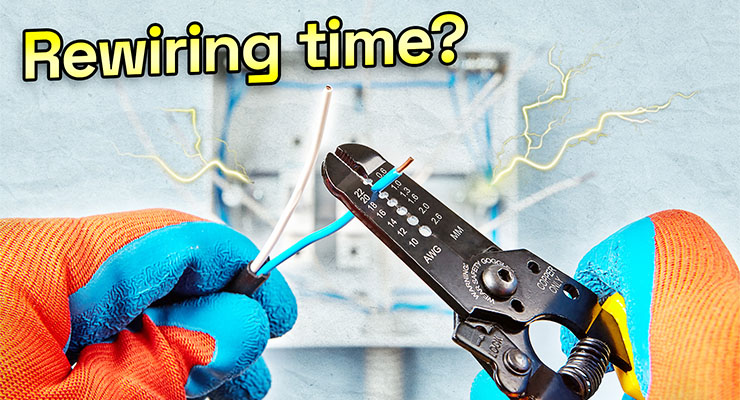Fast read
Home rewiring ensures safety and compliance with Australian electrical standards. Here are five signs your house may need rewiring:
- Sparking Powerpoints: If powerpoints spark or overheat, it poses a fire hazard and damages appliances. Rewiring is crucial to prevent accidents.
- Outdated Wiring: Homes over 30 years old with original wiring may not meet current safety standards. Updating wiring reduces the risk of accidents caused by incompatible appliances and outdated materials.
- Burning Smell: A burning smell indicates wires are overheating or burning. Immediate action, such as shutting off electricity and contacting a professional, is necessary to prevent home fires.
- Flickering Lights: Persistent flickering lights, even after changing bulbs, suggest wiring issues. Rewiring becomes necessary to ensure proper electrical functioning.
- Faulty Circuit Breakers: Regular tripping of circuit breakers because it has exceeded limits indicates faulty wiring. While circuit breakers protect against damage, frequent tripping signifies the need for rewiring to prevent electrical hazards.
With increasing demands on electrical systems and the prevalence of modern appliances, outdated wiring poses significant risks, including fire hazards and equipment damage. Staying vigilant for these signs and addressing them promptly ensures the safety and functionality of your home's electrical infrastructure.
Does my house need rewiring?
House rewiring refers to relaying the electrical wires throughout your home. This ensures the residents are safe and that the wiring system is up to Australian government standards.
This article will give you five signs that it is time to rewire your house as well as when you should get it and what problems can arise if you don’t do one.
Let’s say you plug in a high-power consumer item such as a toaster or microwave, or kettle, and you discover that the light, that was switched on momentarily dims or flickers a little. This is a sign that the power circuit is struggling and has a problem.
The starting current of these items is often high and draws a lot of power initially. When it reaches its operating current, it balances out and the light does not flicker again.
This could indicate that your home does not have sufficient electrical circuits or independent circuit breakers. In the meantime, if this has been going on for a while. Some of the premise’s electrical cables could have heated to a point where the insulation could have melted.
Why the need for rewiring is more important nowadays?
30 years ago, the demand for the electrical systems of a residential home was relatively low compared to today. You would be lucky in the olden days to have a fan, and now a house has at least one or two air conditioning units.
In previous times, we only had one oven with a cooktop. Now we have a high-powered induction cooktop, dishwasher, water heater, deep fryer, range hoods, computers, monitors, etc. All this is running on old wiring and circuit systems.
The old fuses and the few circuits in an older electrical system cannot cope with the higher demand and overloads by all the electrical appliances and devices. Hence electrical fires are more likely.
A normal power or light circuit can only be used for 8A, 10A, or 16A. This means a 10A circuit breaker or old ceramic fuse can only be used with a continuous total power of 2,400W. This can already be reached with one single radiative heater.
Old wiring, out-of-date switchboards, old porcelain fuses and faulty wiring can also cause short circuits and overloading. You don’t want to learn you have plugged in one too many electric consumers and overloaded an old circuitry connected via a ceramic switch with a nail as a fuse (yes, we have seen this).
According to a journal article and study by Macquarie University, “house fires kill more Australians than all-natural hazards” and “most deaths occur at night”. Did you know that about 20% of house fires are caused by sparks from faulty wiring and equipment? According to the Australian Bureau of Statistics (ABS), the 5 top ranking causes of house fires are unattended heat sources, short circuits, ground fault and electrical failure.

So, what should you look for to see if your house needs rewiring?
Sparking powerpoints
If your powerpoints start sparking or overheating. They become a danger to anyone who uses them. Sparks can cause a fire, and overheating can permanently damage your electrical appliances.
What causes these two things is that a spark inside the PowerPoint can burn and fray the wires. Therefore, it is time to rewire if you notice sparks coming from your PowerPoint.
Outdated wires
If you have been in one home for over 30 years and have never had the house rewired, You should get it done ASAP. Over the past four decades, the Australian guidelines on wiring and appliances themselves have drastically changed.
The Australian guidelines are in place to keep the wiring to a safe standard. So, not keeping up with this increases the risk of an accident occurring. More developed appliances may also cause issues with old wires, increasing risk.
Burning smell
If you notice a burning smell around the house or coming from a PowerPoint, your wires are probably burning. This results from a spark burning the wires in your home, similar to what causes sparks coming from your PowerPoint.
If this occurs, turn off your electricity from your circuit box. Then, contact a professional to rewire your house.
Flickering lights
While flickering lights may result from an issue with the light bulb, it could also be from the wiring. If you notice your lights flickering even after changing the bulb, it is a sign that it is time to rewire your house.
Faulty circuit breakers
If an electrical current exceeds the limit of what the circuit breaker can handle, it will cut the power off. This preventative process stops damage from being done to your electrical system. While this is a good thing, when it happens regularly and when it should not happen, it is a result of faulty wiring.



